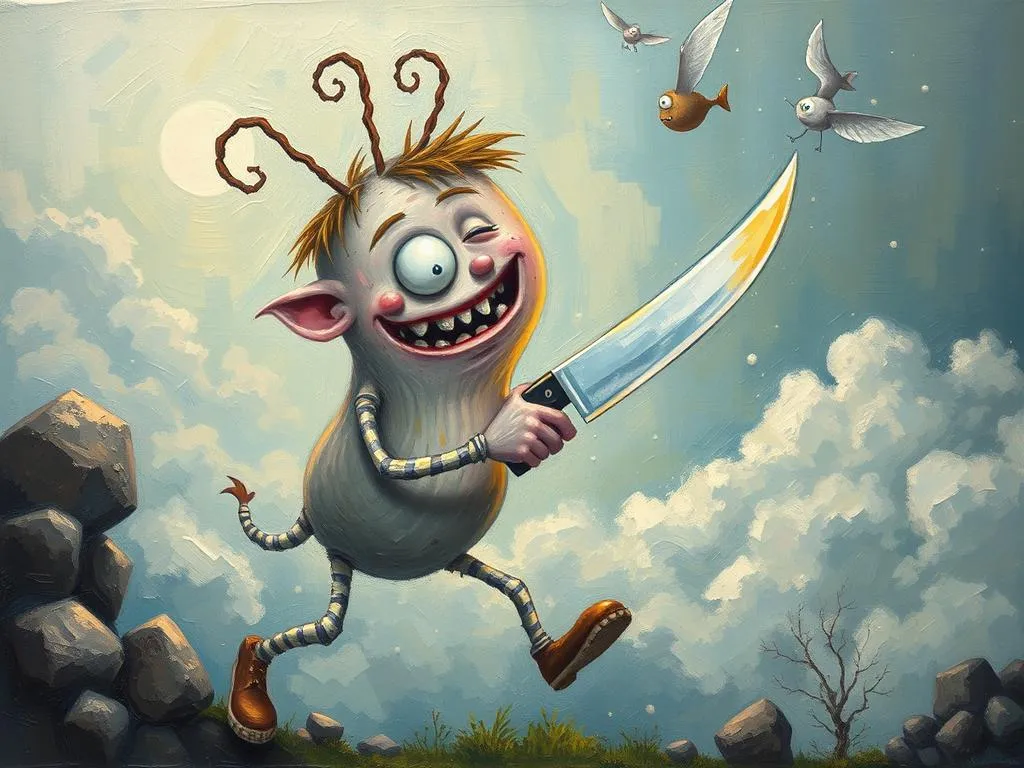
Dreams have fascinated humanity for centuries, serving as a window into our subconscious minds. Among the myriad of dreams we experience, knife-wielding dreams stand out due to their intense imagery and emotional resonance. These dreams often invoke feelings of fear, anxiety, or even empowerment, leading many to ponder their significance. Understanding the meaning behind these dreams can not only provide insight into our internal struggles but also reveal our hidden emotions and desires. This article delves into the symbolism and interpretations of knife-wielding dreams, exploring various scenarios, and offering guidance on how to connect these dreams to real-life situations.
Symbolism and Meaning
The knife in dreams is a multifaceted symbol. On one hand, it can represent danger, aggression, and conflict, evoking feelings of fear and unease. On the other hand, it can symbolize cutting away what no longer serves us, indicating a form of transformation or liberation. The duality of the knife reflects the complexities of our emotions and experiences, serving as a reminder that not all interpretations are straightforward.
In many cultures, knives are associated with power and control. Dreaming of a knife can indicate a desire for assertiveness or an urge to take charge of one’s life. Conversely, it may signal feelings of vulnerability, suggesting that one feels threatened or overwhelmed in waking life. This dual nature of the knife calls for a deeper examination of the emotional context surrounding the dream.
The act of wielding a knife can also represent conflict with others or an internal struggle within oneself. If the dreamer is the one holding the knife, it may signify a confrontation with a challenging situation or a need to defend oneself. If someone else is wielding the knife, it may reflect feelings of being attacked or victimized. This distinction is crucial for understanding the dream’s implications on the dreamer’s current life circumstances.
Key Scenarios and Variations
The context of a knife-wielding dream can drastically alter its interpretation. For instance, if a dreamer finds themselves using a knife to cut through obstacles or barriers, it may symbolize a proactive stance in overcoming life challenges. This scenario can reflect empowerment and a sense of agency, suggesting that the dreamer is actively working to resolve personal issues.
Alternatively, dreaming of being chased by someone with a knife can evoke feelings of anxiety and fear. This scenario may indicate that the dreamer is escaping from a situation or emotion they find threatening. It can also signify unresolved conflicts or repressed feelings that the dreamer is avoiding in their waking life.
Another common scenario involves witnessing a knife fight or violent altercation. This can suggest a need to confront issues in one’s life that have been ignored or suppressed. The dreamer may feel caught in the middle of a conflict, either externally with others or internally within themselves. This scenario calls for introspection and the need to address these underlying tensions to achieve emotional clarity.
There are also dreams where the knife is used for creation rather than destruction. For example, preparing food with a knife may symbolize nurturing relationships or creativity. It can indicate that the dreamer is working towards building something positive in their life, utilizing their skills and talents.
Finally, the emotional state of the dreamer during the knife-wielding dream plays a significant role in its interpretation. Feelings of fear, anger, or empowerment experienced in the dream can provide clues to the dreamer’s current emotional landscape. Assessing these feelings can help the dreamer better understand their real-life challenges and motivations.
Real-Life Connections and Takeaways
Connecting knife-wielding dreams to real-life situations can be a powerful tool for self-reflection. It is essential for dreamers to consider their waking life circumstances and how they may relate to the themes of conflict, empowerment, or transformation represented by the knife. Engaging in this reflective practice can lead to valuable insights and personal growth.
For instance, if a dreamer frequently experiences knife-wielding dreams during a stressful period, it may indicate that they are grappling with feelings of vulnerability or fear in their waking life. This awareness can prompt the dreamer to confront these feelings, assess their sources, and develop strategies to cope with stress more effectively. Journaling about the emotions felt during the dream can also aid in processing one’s thoughts and feelings.
Moreover, if the dreamer recognizes a pattern of aggression or conflict in their dreams, it may signal a need to address unresolved issues in their relationships. Open communication with those involved can facilitate healing and resolution, reducing the likelihood of such dreams recurring.
Additionally, knife-wielding dreams can serve as a reminder to evaluate the aspects of life that may require cutting away or transformation. This may involve letting go of toxic relationships, unhealthy habits, or limiting beliefs. Embracing change and taking proactive steps towards personal growth can lead to a more fulfilling life, reducing the prevalence of distressing dreams.
In a more positive light, dreaming of wielding a knife for creative purposes can inspire the dreamer to explore their passions and talents. Engaging in creative activities or hobbies can foster a sense of empowerment and accomplishment, redirecting any negative energy into productive outlets.
Ultimately, self-reflection is key when interpreting knife-wielding dreams. By examining the emotions and scenarios present in the dream, individuals can gain a clearer understanding of their subconscious mind and its messages. This awareness can guide them in making meaningful changes in their waking life.
Conclusion
Knife-wielding dreams are rich with symbolism and meaning, inviting dreamers to explore the depths of their emotions and experiences. They can signify conflict, empowerment, and transformation, urging individuals to confront their fears and embrace change. By analyzing the various scenarios and emotional contexts of these dreams, readers can uncover valuable insights into their waking life challenges.
Encouraging personal reflection on the significance of these dreams can lead to a deeper understanding of oneself and foster personal growth. As we navigate the complexities of life, our dreams serve as powerful tools for self-exploration, offering messages that, when heeded, can illuminate our paths forward. Whether we find ourselves cutting through obstacles or grappling with fear, the knife in our dreams can guide us towards a more empowered and authentic existence.







